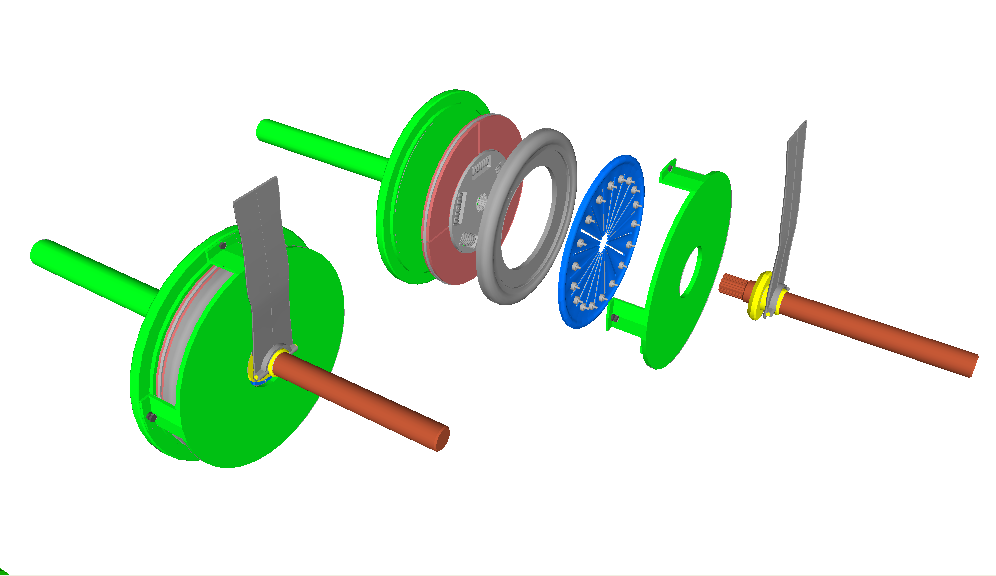|
Rolamite
A Rolamite is a technology for very low friction bearings developed by Sandia National Laboratories in the 1960s. It consists of two cylindrical rollers held captive in a channel by an S-shaped metal strip. The strip is under tension, which keeps the rollers pressed together with the strip between them. The rollers move linearly within the channel as they counter-rotate. During the motion each contact surface has the same surface velocity, which results in very low friction. The Rolamite can be used in various ways such as a component in switches, thermostats, valves, pumps, and clutches. Development The Rolamite was invented by Sandia engineer Donald F. Wilkes and was patented on June 24, 1969. It was invented while Wilkes was working on a miniature device to detect small changes in the inertia of a small mass. After testing an S-shaped metal foil, which he found to be unstable to support surfaces, the engineer inserted rollers into the S-shaped bends of the band, producing a mec ... [...More Info...] [...Related Items...] OR: [Wikipedia] [Google] [Baidu] |
Bearing (mechanical)
A ball bearing A bearing is a machine element that constrains relative motion to only the desired motion and reduces friction between moving parts. The design of the bearing may, for example, provide for free linear movement of the moving part or for free rotation around a fixed axis; or, it may prevent a motion by controlling the vectors of normal forces that bear on the moving parts. Most bearings facilitate the desired motion by minimizing friction. Bearings are classified broadly according to the type of operation, the motions allowed, or the directions of the loads (forces) applied to the parts. The term "bearing" is derived from the verb " to bear"; a bearing being a machine element that allows one part to bear (i.e., to support) another. The simplest bearings are bearing surfaces, cut or formed into a part, with varying degrees of control over the form, size, roughness, and location of the surface. Other bearings are separate devices installed into a machine or mach ... [...More Info...] [...Related Items...] OR: [Wikipedia] [Google] [Baidu] |
Scrollerwheel
A scrollerwheel is a mechanical device composed of a number of rollers (four or more) and connective bands under tension, which wrap around and weave between the rollers forming a self-supporting cluster possessing a central roller. The cluster of rollers is bound by the connective bands in such a way that the static friction between the rollers and bands prevent the rollers from slipping as they roll and orbit the central roller. 'Business Week'' August 14, 1995 Scrollerwheels are related in operational principle to linear bearings (developed at |
Friction
Friction is the force resisting the relative motion of solid surfaces, fluid layers, and material elements sliding against each other. Types of friction include dry, fluid, lubricated, skin, and internal -- an incomplete list. The study of the processes involved is called tribology, and has a history of more than 2000 years. Friction can have dramatic consequences, as illustrated by the use of friction created by rubbing pieces of wood together to start a fire. Another important consequence of many types of friction can be wear, which may lead to performance degradation or damage to components. It is known that frictional energy losses account for about 20% of the total energy expenditure of the world. As briefly discussed later, there are many different contributors to the retarding force in friction, ranging from asperity deformation to the generation of charges and changes in local structure. When two bodies in contact move relative to each other, due to these variou ... [...More Info...] [...Related Items...] OR: [Wikipedia] [Google] [Baidu] |
Sandia National Laboratories
Sandia National Laboratories (SNL), also known as Sandia, is one of three research and development laboratories of the United States Department of Energy's National Nuclear Security Administration (NNSA). Headquartered in Kirtland Air Force Base in Albuquerque, New Mexico, it has a second principal facility next to Lawrence Livermore National Laboratory in Livermore, California, and a test facility in Waimea, Kauai, Hawaii. Sandia is owned by the U.S. federal government but privately managed and operated by National Technology and Engineering Solutions of Sandia, a wholly owned subsidiary of Honeywell International. Established in 1949, SNL is a "multimission laboratory" with the primary goal of advancing U.S. national security by developing various science-based technologies. Its work spans roughly 70 areas of activity, including nuclear deterrence, arms control, nonproliferation, hazardous waste disposal, and climate change. Sandia hosts a wide variety of research i ... [...More Info...] [...Related Items...] OR: [Wikipedia] [Google] [Baidu] |
Thermostat
A thermostat is a regulating device component which senses the temperature of a physical system and performs actions so that the system's temperature is maintained near a desired setpoint. Thermostats are used in any device or system that heats or cools to a setpoint temperature. Examples include building heating, central heating, air conditioners, HVAC systems, water heaters, as well as kitchen equipment including ovens and refrigerators and medical and scientific incubators. In scientific literature, these devices are often broadly classified as thermostatically controlled loads (TCLs). Thermostatically controlled loads comprise roughly 50% of the overall electricity demand in the United States. A thermostat operates as a "closed loop" control device, as it seeks to reduce the error between the desired and measured temperatures. Sometimes a thermostat combines both the sensing and control action elements of a controlled system, such as in an automotive thermostat ... [...More Info...] [...Related Items...] OR: [Wikipedia] [Google] [Baidu] |
Clutch
A clutch is a mechanical device that allows an output shaft to be disconnected from a rotating input shaft. The clutch's input shaft is typically attached to a motor, while the clutch's output shaft is connected to the mechanism that does the work. In a motor vehicle, the clutch acts as a mechanical linkage between the engine and transmission. By disengaging the clutch, the engine speed (RPM) is no longer determined by the speed of the driven wheels. Another example of clutch usage is in electric drills. The clutch's input shaft is driven by a motor and the output shaft is connected to the drill bit (via several intermediate components). The clutch allows the drill bit to either spin at the same speed as the motor (clutch engaged), spin at a lower speed than the motor (clutch slipping) or remain stationary while the motor is spinning (clutch disengaged). Types Dry clutch A ''dry clutch'' uses dry friction to transfer power from the input shaft to the output shaft, f ... [...More Info...] [...Related Items...] OR: [Wikipedia] [Google] [Baidu] |
Linear Bearing
A linear-motion bearing or linear slide is a Bearing (mechanical), bearing designed to provide free motion in one direction. There are many different types of linear motion bearings. Motorized linear slides such as machine slides, X-Y tables, roller tables and some Dovetail rail, dovetail slides are bearings moved by drive mechanisms. Not all linear slides are motorized, and non-motorized dovetail slides, ball bearing slides and roller slides provide low-friction linear movement for equipment powered by inertia or by hand. All linear slides provide linear motion based on bearings, whether they are ball bearings, dovetail bearings, linear roller bearings, magnetic bearing, magnetic or fluid bearings. X-Y tables, linear stages, machine slides and other advanced slides use linear motion bearings to provide movement along both X and Y multiple axis. Rolling-element bearing A rolling-element bearing is generally composed of a sleeve-like outer ring and several rows of balls retained b ... [...More Info...] [...Related Items...] OR: [Wikipedia] [Google] [Baidu] |
Popular Mechanics
''Popular Mechanics'' (often abbreviated as ''PM'' or ''PopMech'') is a magazine of popular science and technology, featuring automotive, home, outdoor, electronics, science, do it yourself, and technology topics. Military topics, aviation and transportation of all types, space, tools and gadgets are commonly featured. It was founded in 1902 by Henry Haven Windsor, who was the editor and—as owner of the Popular Mechanics Company—the publisher. For decades, the tagline of the monthly magazine was "Written so you can understand it." In 1958, PM was purchased by the Hearst Corporation, now Hearst Communications. In 2013, the US edition changed from twelve to ten issues per year, and in 2014 the tagline was changed to "How your world works." The magazine added a podcast in recent years, including regular features ''Most Useful Podcast Ever'' and ''How Your World Works''. History ''Popular Mechanics'' was founded as a weekly in Chicago by Henry Haven Windsor, with the first ... [...More Info...] [...Related Items...] OR: [Wikipedia] [Google] [Baidu] |
Friction Coefficient
Friction is the force resisting the relative motion of solid surfaces, fluid layers, and material elements sliding against each other. Types of friction include dry, fluid, lubricated, skin, and internal -- an incomplete list. The study of the processes involved is called tribology, and has a history of more than 2000 years. Friction can have dramatic consequences, as illustrated by the use of friction created by rubbing pieces of wood together to start a fire. Another important consequence of many types of friction can be wear, which may lead to performance degradation or damage to components. It is known that frictional energy losses account for about 20% of the total energy expenditure of the world. As briefly discussed later, there are many different contributors to the retarding force in friction, ranging from asperity deformation to the generation of charges and changes in local structure. When two bodies in contact move relative to each other, due to these various ... [...More Info...] [...Related Items...] OR: [Wikipedia] [Google] [Baidu] |
Ball Bearing
A ball bearing is a type of rolling-element bearing that uses balls to maintain the separation between the bearing races. The purpose of a ball bearing is to reduce rotational friction and support radial and axial loads. It achieves this by using at least two races to contain the balls and transmit the loads through the balls. In most applications, one race is stationary and the other is attached to the rotating assembly (e.g., a hub or shaft). As one of the bearing races rotates it causes the balls to rotate as well. Because the balls are rolling, they have a much lower coefficient of friction than if two flat surfaces were sliding against each other. Ball bearings tend to have lower load capacity for their size than other kinds of rolling-element bearings due to the smaller contact area between the balls and races. However, they can tolerate some misalignment of the inner and outer races. Common ball bearing designs include ''angular contact, axial, deep-groove,'' an ... [...More Info...] [...Related Items...] OR: [Wikipedia] [Google] [Baidu] |
Accelerometer
An accelerometer is a device that measures the proper acceleration of an object. Proper acceleration is the acceleration (the rate of change (mathematics), rate of change of velocity) of the object relative to an observer who is in free fall (that is, relative to an inertial frame of reference). Proper acceleration is different from coordinate acceleration, which is acceleration with respect to a given coordinate system, which may or may not be accelerating. For example, an accelerometer at rest on the surface of the Earth will measure an Gravitational acceleration, acceleration due to Earth's gravity straight upwards of about Standard gravity, ''g'' ≈ 9.81 m/s2. By contrast, an accelerometer that is in free fall will measure zero acceleration. Accelerometers have many uses in industry, consumer products, and science. Highly sensitive accelerometers are used in inertial navigation systems for aircraft and missiles. In unmanned aerial vehicles, accelerometers help to stabili ... [...More Info...] [...Related Items...] OR: [Wikipedia] [Google] [Baidu] |





